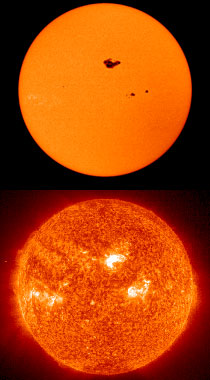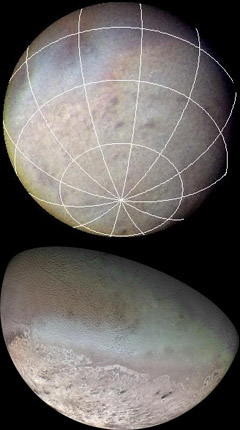Click on image for full size
Images courtesy of SOHO (ESA & NASA).
Related links:
Kelvin Temperature Scale Used in Astronomy
The Kelvin scale is a temperature scale that is often used in astronomy and space science. You are probably more familiar with the Celsius (or Centigrade) scale, which is part of the metric system of measures, and the Fahrenheit scale, which is used in the English system.
Why do astronomers need another temperature scale? On Earth, the temperatures we most frequently encounter are often within, or close to, the range over which water is liquid. A temperature scale that has "reasonable" numbers to represent the most common temperatures encountered makes sense for day-to-day use on Earth. For example, Earth's average temperature is around 15° C (49° F). It is convenient to be able to say that tomorrow's weather will bring a high temperature of 20° C (58° F). It would not be convenient to use a scale that had very large numbers (like 6,437°) or very small or negative numbers (like 0.052° or -147°) for the most commonly encountered situations. The Celsius and Fahrenheit scales are set so that common Earthly temperatures lie in a range that lets us use "reasonable" numbers.
In space (including on other planets and moons, inside of stars, and so on), temperatures range across much more extreme values than they do on our comfortable Earth. Comets and icy moons, for example, often have temperatures close to absolute zero. Stars, on the other hand, can have temperatures of thousands of degrees or higher. The Kelvin scale avoids negative numbers altogether, so it is much more convenient to use for extremely cold temperatures. Since the size of a degree in the Kelvin and Celsius scales is just a bit larger than half a degree in the Fahrenheit scale, really hot temperatures can be represented by smaller numbers in Kelvin and Celsius than in Fahrenheit. Thus, the Kelvin scale is often the temperature scale of choice amongst astronomers and space scientists, though people in other fields sometimes use it too.














